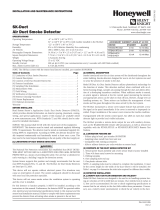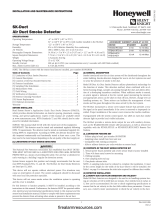
Install the inlet tube as follows:
1. Drill a 3/4-inch hole in the duct directly opposite the
hole already drilled for the inlet tube.
2. Slide the inlet tube with the flange into the centermost
housing bushing. Position the tube so that the arrows
point into the air flow. Secure the tube flange to the
housing bushing with two #6 self-tapping screws.
3. From inside the duct, couple the other section of the
inlet tube to the section already installed using the 1/2-
inch conduit fitting supplied. Make sure that the holes
on both of the air inlet tubes are lined up and facing into
the air flow.
4. Trim the end of the tube protruding through the duct so
that 1 to 2 inches of the tube extend outside the duct.
Plug this end with the end plug and tape closed any
holes in the protruding section of the tube. Be sure to
seal the duct when the tube protrudes.
NOTE: An alternate method to using the ST-10 is to use
two ST-5 inlet tubes. Remove the flange from one
of the tubes and install as described above. After
the installation, use electrical tape to close off
some of the sampling holes so that there is a to-
tal of 10 to 12 holes spaced as evenly as possible
across the width of the duct.
Air currents inside the duct may cause excessive vibration,
especially when the longer sampling tubes are used. In
these cases a 3 inch floor flange (available at most plumb-
ing supply stores) may be used to fasten the sampling tube
to the other side of the duct. When using the flange/con-
nector mounting technique, drill a 1 inch to 1-1/4-inch hole
where the flange will be used.
[5.4.3] Modifications Of Inlet Sampling Tubes
There may be applications where duct widths are not what
is specified for the installation. In such cases, it is permis-
sible to modify an inlet sampling tube that is longer than
necessary to span the duct width.
Use a 0.193-inch diameter (#11) drill and add the appro-
priate number of holes so that the total number of holes
exposed to the air flow in the duct is 10 to 12. Space the
additional holes as evenly as possible over the length of the
tube.
[5.5] Field Wiring
Installation Guidelines
All wiring must be installed in compliance with the National
Electrical Code and the local codes having jurisdiction.
Proper wire gauges should be used. The conductors used
to connect smoke detectors to control panels and accessory
devices should be color-coded to reduce the likelihood of
wiring errors. Improper connections can prevent a system
from responding properly in the event of a fire.
For signal wiring, (the wiring between interconnected de-
tectors or from detectors to auxiliary devices), it is usually
recommended that single-conductor wire be no smaller
than 18 gauge. The duct detector terminals accommodate
wire sizes up to 14 gauge. The last foot of conduit should
be flexible steel conduit (available in electrical supply
houses), which facilitates installation and puts less strain
on the conduit holes in the housing. Solid conduit connec-
tions may be used, if desired.
Smoke detectors and alarm system control panels have
specifications for allowable loop resistance. Consult the
control panel manufacturer’s specifications for the total
loop resistance allowed for the particular model control
panel being used before wiring the detector loop.
Wiring Instructions
The DH400ACDCP detectors are designed for easy wiring.
The housing provides a terminal strip with clamping plates.
Wiring connections are made by stripping about 3/8-inch
of insulation from the end of the wire, sliding the bare end
under the plate, and tightening the clamping plate screw.
The DH400ACDCP duct detector is designed to operate
from 24 VDC, 24 VAC, 120 VAC, or 240 VAC.
The detector may be wired for interconnection to UL listed
control panels, or for stand alone service per NFPA 90A.
Refer to the wiring diagrams of Figures 6, 7, and 8 to select
the appropriate circuit for your application.
D400-13-00 5 I56-555-09R


















